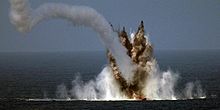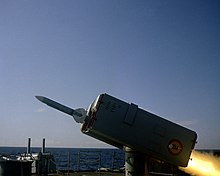RIM-7 Sea Sparrow
| RIM-7 Sea Sparrow | |
|---|---|
|
|
|
| General Information | |
| Type | Anti-aircraft missile |
| NATO designation | RIM-7M Sea Sparrow |
| Country of origin |
|
| Manufacturer | Raytheon |
| development | 1965 |
| Commissioning | 1967 |
| Working time | in service |
| Unit price | 165,400 US dollars |
| Technical specifications | |
| length | 3.98 m |
| diameter | 203 mm |
| Combat weight | 228 kg |
| span | 1,020 mm |
| drive | Hercules MK 58 solid rocket engine |
| speed | Mach 3.6-4.0 |
| Range | 20-26 km |
| Service ceiling | 15,240 m |
| Furnishing | |
| steering | Inertial navigation system |
| Target location | semi-active radar target search (SARH) |
| Warhead | 40 kg fragmentation warhead WDU-27 / B |
| Detonator | Radar proximity fuse, impact fuse |
| Weapon platforms | Ships |
| Lists on the subject | |
The RIM-7 Sea Sparrow (also NATO Sea Sparrow Missile System (NSSM) ) is a ship-based, radar-controlled medium-range air defense system based on the airborne AIM-7 Sparrow . It is produced by the US Corporation Raytheon .
development
In the early 1960s , the US Navy began developing an air defense system for use on ships, with particular emphasis on combating anti-ship missiles . It was called BPDMS (Basic Point Defense Missile System) and was intended to be used as the standard self-defense system on ships. Initially, this was to be implemented by modifying the existing MIM-46 Mauler system. Since its development was stopped in 1965, it was decided to use a modified AIM-7E guided missile as a basis. The resulting RIM-7E5 Sea Sparrow missile was identical to the airborne version in almost every area. Launched in 1967, the missile was launched from a Mk 25 launcher.
technology

The Sea Sparrow is largely identical to the airborne AIM-7 Sparrow . However, a special feature is the steering system with two parallel working CW - Feuerleitradaren . As with the Sparrow, the first radar with a small opening angle is used to illuminate the target and thus ensure a precise target approach. The additional second radar, on the other hand, has a relatively large opening angle and is used to filter out the clutter that is created by the sea surface. This technique was introduced to enable effective combat against low-flying targets such as anti-ship missiles. However, this technology could only be fully used with the RIM-7F Block I.
In addition, the Sea Sparrow also has a ground-to-ground mode, which enables the combat against surface targets. This is typical of US-made ship-based surface-to-air guided missiles. Such a mode was also introduced for the standard missile air defense missile . Due to the relatively small warhead of 40 kg, only smaller ships can be fought effectively. Inflatable boats have been sunk with the help of the Sea Sparrow during exercises.
future
The Sea Sparrow was the first US anti-aircraft missile specially designed to combat anti-ship missiles. However, these have developed significantly, especially in terms of maneuverability and speed. An example of this is the SS-N-22 Sunburn , which performs strong maneuvers at high speed on the final approach. Since the airborne Sparrow already had problems with such targets, it can be assumed that the Sea Sparrow would not achieve a high probability of being hit by such a missile. The Sea Sparrow's minimum deployment height of 6 meters also limits its use against modern missiles, which usually only fly 2 to 5 meters above the water. Because of these deficits, a new guided missile was developed which can also fight advanced anti-ship missiles effectively: The RIM-162 Evolved Sea Sparrow Missile , also known as the ESSM. It is a fundamental further development of the Sea Sparrow, from which only some parts of the steering system have been taken over. At close range, the Sea Sparrow has been supplemented by the RIM 116 RAM system since the 1990s .
Despite the disadvantages of the system, the Sea Sparrow is still in use on many ships, mainly for cost reasons. The ESSM can also be used in conjunction with the Mk-29 starter so that no extensive modifications need to be made in the area of the starter when retrofitting. However, the radar and steering systems must be adapted to the ESSM, which can sometimes lead to considerable additional costs.
variants

- RIM-7E5: Original version that differs only slightly from the AIM-7E.
-
RIM-7F: A more advanced version, but hardly ever produced because the focus was on developing a ship-based variant of the AIM-7M.
- RIM-7F Block I: Tests showed the Sea Sparrow had problems fighting low-level anti-ship missiles , which have now posed the greatest threat to the US fleet. Therefore, this variant was created, which could fall back on an additional radar guidance in the low flight area and an improved proximity fuse. This enabled targets below 15 meters to be fought.
- RIM-7F Block II: In this version, the ECCM capacities have been expanded. However, it does not include the improvements introduced to the Block I missiles.
- RIM-7H: This variant was fitted with modified wings to fit into the smaller Mk-29 starter. Otherwise it has the characteristics of a RIM-7E5 and is less powerful than the RIM-7F.
- RIM-7M: With further adjustments, the Sea Sparrow could now be fired with the typical 8-way starter Mk 29. Technically, it was practically identical to the AIM-7M and combines the capabilities of the RIM-7F Block I and Block II.
-
RIM-7P: Like the airborne AIM-7P, this new variant has been divided into two blocks, with both sub-variants being equipped with an additional data link for improved steering during the cruise flight:
- RIM-7P Block I: In this version, the performance in low flight and the proximity fuse have been improved. Thanks to the “Jet Vane Control” system, the rocket can now also be launched from Mk 41 VLS starters .
- RIM-7P Block II: Here the computer components were modernized, which now had more memory bandwidth and an EPROM and a new proximity fuse. The software was also extensively updated, so that the performance compared to low-flying targets in connection with the new target system was significantly increased. The ECCM capacities have also been expanded.
- RIM-7R: This was to become the sea-based equivalent of the AIM-7R, which was to be equipped with an additional infrared seeker head from the AIM-9 Sidewinder . Like the airborne version, the program was canceled for cost reasons.
- RIM-7T: This is the unofficial name for the next Sea Sparrow generation, the RIM-162 ESSM .
Platforms
Destroyers: Spruance Class , Arleigh Burke Class , Murasame Class , Hatsuyuki Class , Asagiri Class , Shirane Class , Okpo Class
Frigates: Wielingen class , Tromp class , Kortenaer class , Oslo class , Knox class , Anzac class , Halifax class , Brandenburg class , Bremen class , Karel doorman class
Supply Ships: Supply Class , Wichita Class , Sacramento Class
Airplane / Helicopter Carriers: Forrestal Class , Iwo Jima Class , Tarawa Class , Wasp Class , Nimitz Class , USS Enterprise , Kitty Hawk Class


